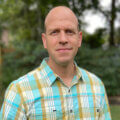
Stephen Heywood received his Bachelors of Science Degree in ceramics from Southern Utah University and his Masters of Fine Arts Degree in ceramics from Edinboro University of Pennsylvania. From 2001-2003 Heywood acted as the Coordinator and instructor for the Erie Art Museum’s “Clay Space” community ceramics program in Erie, Pennsylvania. He has been a visiting artist at a number of colleges and Universities throughout the country. Heywood Exhibits his work extensively and had been in over 300 national juried shows and invitationals. In 2004, Heywood was selected to represent the United States in the First International, Ceramics Journal Editors Symposium, Emerging Artist exhibition, in Xian China. In 2011, Heywood participated in and won “Best in 3-D” in the Westmoreland Arts National in Westmoreland Pennsylvania. He is a member of The National Council on Education for the Ceramic Arts and a former board member for Florida Craftart. Selected publications include: 500 Cups, 500 Bowls, The Best of 500 Ceramics, Image Transfer on Clay, Printing on Clay, and the Periodicals Clay Times and Ceramics Monthly. As an artist, he is primarily interested in ceramic wheel-thrown vessels and hand-built mechanical forms that relate to function. His work is influenced by architectural structures including factories, silos, and water towers. These vessels are often composed of many wheel-thrown and hand-built parts and take their shape as small “functional sculpture”. He is currently Professor of Ceramics at the University of North Florida in Jacksonville.
My work draws influences from things that are industrial, mechanical, and manmade. I often reference architectural structures that have surrounded me throughout my life. These consist of barns, silos, factories, and water towers as well as many other structures. Many of these buildings are used for containment, and are in essence vessels of function. These buildings, which are often run-down and abandoned show with their weathered exterior textures of flaking paint and rusted steel, a course of production and history. In my work, I look to their weathered exterior textures for inspiration and ideas on surface treatment. The simple geometric shapes of these structures are often echoed in the main body and various parts of my pieces. Chimneys, windows, vents, smokestacks and piping are integrated in my work as decoratively-charged elements of visual interest. Sometimes these elements are incorporated into my work in the form of handles, lids, and spouts. I also incorporate numbers and symbols on my work through the use of slip stencils and laser print transfers. These markings lend variety and reference the architectural structures to which I look for inspiration. I often leave marks on the form as evidence of the working process. These subtle marks are then accentuated by the atmospheric firing processes of soda and wood and help to give my work the same sense of history and aged qualities that I observe in the buildings and objects that inspire me.




